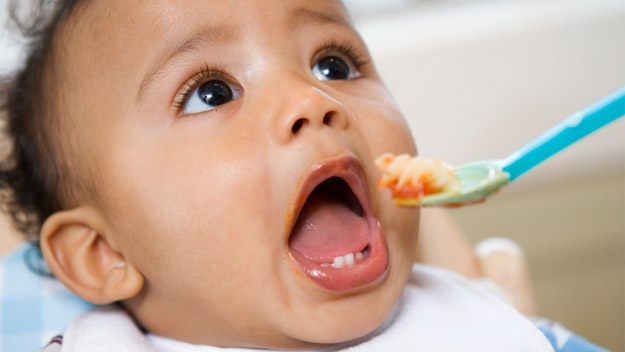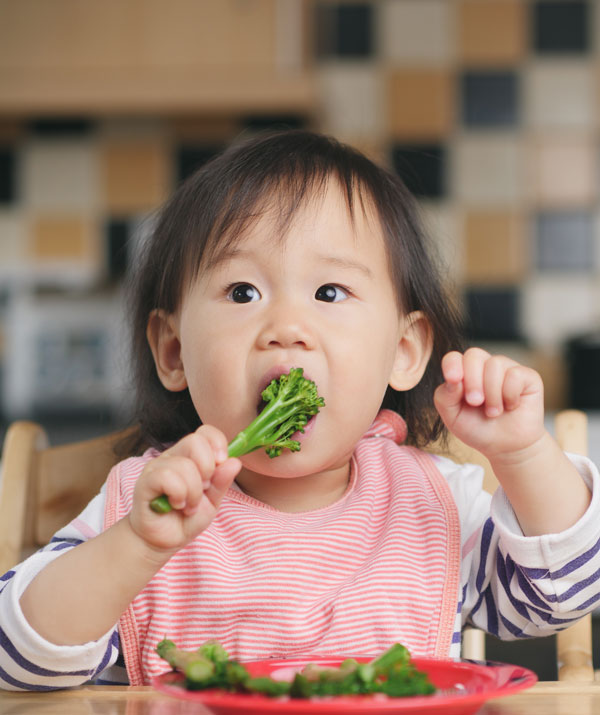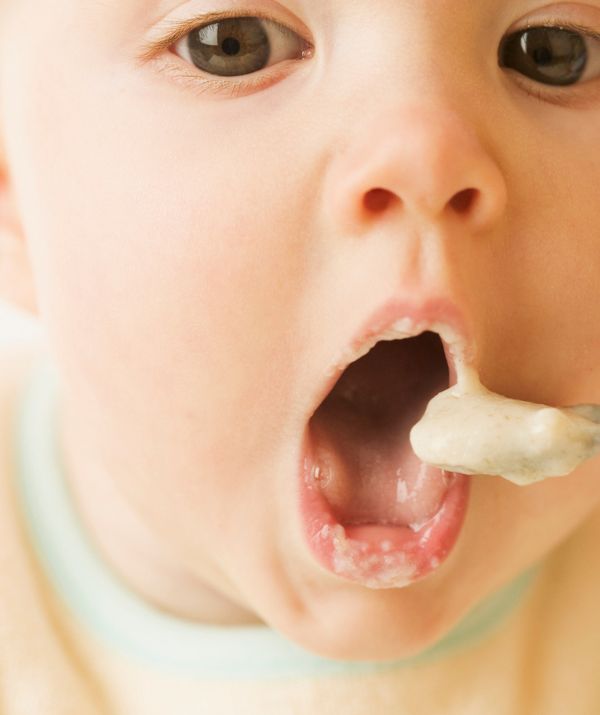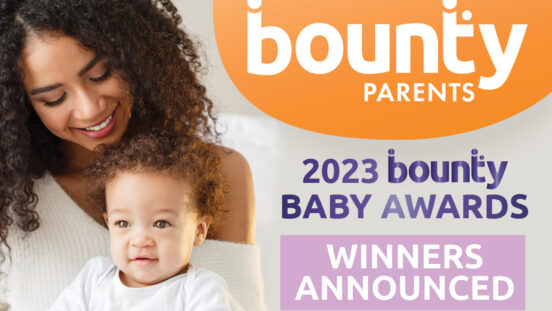Grub’s up

Starting solids can be easy with our must-read guide.
Typical. No sooner have the two of you mastered breastfeeding than your tot’s ready to start eating solids.
The World Health Organization says that, ideally, solid food should not be introduced until your baby is about six months old – but defintitely not before four months (check with your health nurse or GP if you’re unsure). Before six months, breastmilk provides all the nutrients they need and exclusive breastfeeding will strengthen their immunity and prevent allergies.
There’s no doubt that deciding when to start offering solid foods to your little one can be can be stressful – after all, he’s your most treasured posssession! Then there’s the mess and the time it takes to get even a single spoonful down the hatch.
But don’t be put off. Infants eat very little at first and spend a long time doing it. Your baby may pull a face or spit food straight back out, but that needn’t mean he doesn’t like it, just that it’s different.

By about eight months your baby should be ready for finger foods.
Ready, steady – start solids!
Your baby will probably let you know when they’re ready for solids. They may still seem hungry after their milk, or start waking at night when previously they slept through. They may take an interest in your food too – watching you eat, making chewing motions or trying to grab food off your plate.
Don’t leave starting solids any later than six months because the stores of iron they were born with will start to run out, and milk alone won’t meet their nutritional needs.
Once your baby has started solids, you’ll be surprised how quickly their appetite grows. By about eight months they should be ready for finger foods bite-sized chunks that they can feed themselves. Baby will probably want their own spoon between nine and 12 months, but it may be a while before they develop the coordination to get it from bowl to mouth!
Products you need when introducing solid foods
- Unbreakable bowl
- Infant spoon – a plastic one with soft, rounded edges is kind to gums
- Fork, sieve or blender for pureeing and mixing
- Bibs
- Highchair
- Splash mat or newspaper to protect the floor
- Sterile containers with lids for storing foods
Step-by-step guide to baby’s first solid ‘meal’
- Step 1: Choose your moment. Make sure you’re both relaxed, and your baby isn’t too tired or hungry. Lunchtime is ideal as breakfast can be too hectic, and a first meal at dinner could disturb his bedtime routine.
- Step 2: Take the edge off his appetite by giving him a small milk feed first. For now you just want them to get used to the taste and texture of solids, not give them a full meal.
- Step 3: Sit him in his highchair. Try to minimise distractions like the TV.
- Step 4: Start with baby rice. Mix it with breastmilk. It should be lukewarm, not hot.
- Step 5: Put a tiny amount in their mouth using a soft spoon. If it comes straight back out, try again, as long as Bub isn’t upset. Smile, chat and tell them how yummy it is.
- Step 6: Don’t overdo it. A few mouthfuls are plenty at first. Be guided by baby. It’s quite normal for them to want several spoonfuls one day, and nothing the next. Continue to give your baby at least 600ml of milk a day.
Your starting solids schedule
Where to start?! Use this simple four-week starting solids schedule alongside your breastfeeding routine as your guide to what foods to offer and when.
Week 1
Foods to offer – Baby rice and purees of single vegetables for example, carrot, parsnip, potato, sweet potato, zucchini or cauliflower
How much – Offer a few teaspoonfuls a day, unless your baby wants more
Week 2
Foods to offer – Introduce purees of fruit like apple, pear or mashed banana
How much – Two servings a day, if your baby’s happy
Week 3
Foods to offer – If he’s over six months, try dairy products like mild cheddar cheese or unsweetened natural yoghurt
How much – Two meals a day
Week 4
Foods to offer – From six months, purees of protein-rich foods like chicken, lean meat or lentils
How much – Two or three meals a day, with at least one serving of protein
Solids based on age range
Here are some ideas on the sorts of food you can offer as your baby grows and becomes a more confident eater.
6 to 9 months
Foods to offer – Citrus fruits, hard-boiled eggs, wheat-based foods (bread, pasta, etc), strawberries, boneless fish. Introduce lumpier foods and, from seven months, finger food like breadsticks or chunks of fruit or soft steeamed vegies. We’d love to be able to offer fresh and homemade foods all the time, but parents need to cut themselves some slack! There is a host of great quality prepared baby foods on the market and offering something like an Organic Smoothie Bowl with Banana, Apple and Oats from Little Bellies provide nutritious options (think: no salt, no sugar; organic fruits and grains) that can take some of the pressure off.
How much – Three meals a day
9 to 12 months
Foods to offer – Small, unsalted portions of normal ‘adult’ food, chopped up, and encourage him to eat with the family
How much – Three meals a day, with healthy snacks in between if he’s hungry

Yoghurt and soft dairy foods can be offered from six months of age.
The solids NOT to offer to your six-month-old
Beyond six months, most foods are suitable, but here’s what to avoid:
- Whole nuts: a choking hazard for under-fives. If your family has a history of allergies, be guided by your healthcare provider before introducing smooth peanut butter and other nut-based products.
- Salt: before 12 months, it could cause kidney damage. From 12 months, use only sparingly.
- Honey: it can cause botulism (serious food poisoning) before 12 months.
- Raw or undercooked eggs: avoid them until 12 months because of the risk of salmonella food poisoning.
- Tea, coffee and fizzy drinks: the caffeine stops your baby’s body absorbing iron.
- Low-fat foods: your tot needs lots of calories to grow.
- Adult gravy and sauces: often very high in salt.
- High-fibre foods like added-bran cereals: too hard to digest.
- Cow’s milk: it can cause allergies before 12 months, although you can use it in cooking.

Be guided by how much your tot wants to eat as they might take a while to get used to neew textures and flavours.
How to spot the signs of food allergies when starting solids
True food allergies are, thankfully, rare, but can be serious. Wheat, dairy, eggs and peanuts are the most common culprits. The symptoms include wheezing, a rash and swelling of the lips and tongue and, in extreme cases, your baby could even stop breathing. The reaction generally develops within an hour of eating. You should always consult your GP if you suspect your baby has a food allergy, and if the reaction is severe, call an ambulance immediately.
Food intolerances are more common but less severe. They tend to cause digestive problems, like colic, diarrhoea, constipation and vomiting. Your GP may refer your baby to a dietician. Whether he has a true allergy or an intolerance, complete avoidance of the foods in question may be the only solution, however there are milk and gluten alternatives today.
To avoid allergies and intolerances, ideally breastfeed exclusively until six months, and stick to baby rice, fruit and veg for the first two weeks of weaning. Introduce potential problem foods gradually wheat, dairy and eggs shouldn’t be given before six months. Avoid cow’s milk (except in cooking) until 12 months, and peanuts, in any form, until age three if there’s a family history of allergies.
If you find that your baby’s tummy becomes a little unsettled as you start to introduce a variety of solid foods, you can add a supplement such as a probiotic that helps support digestive health and their immune system. Activated Probiotics Biome Baby is made specifically for bub’s sensitive tum and may reduce symptoms of tummy upsets or colic. It’s easy to add it to water or expressed breastmilk.




